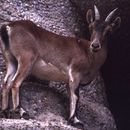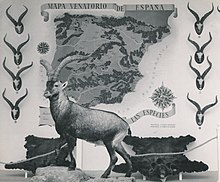en
names in breadcrumbs


Perception Channels: tactile ; chemical
Conservation efforts are being focused on habitat preservation and restoration and looking at competition with introduced species such red deer, like those introduced into Carzorla-Segura park. (Grzimek, 1990)
US Federal List: endangered
CITES: no special status
IUCN Red List of Threatened Species: least concern
See reproduction.
Spanish ibex potentially compete with grazing livestock. (Gortazac, 2000)
Spanish ibex are prized as trophy game animals. The flesh is considered a delicacy. They are important for tourism, bringing many people to the parks on the Iberian Peninsula. (Grzimek, 1990)
Positive Impacts: food ; body parts are source of valuable material; ecotourism
Because of its feeding behavior, C. pyrenaica influences succession of plants in its habitat. It also is a primary consumer, converting the energy stored in plants to a form which is then available to its predators.
Ecosystem Impact: creates habitat
Spanish ibex feed primarily by browsing. Their main forage is Holm oak (Quercus ilex). They browse these oaks as well as feed on the acorns. They also feed on forbs (5% of diet) and grasses (10% of diet). Forage of forbs and grasses is selected more in spring and early summer. (Garcia-Gonzales, 1992; Martinez, 1988)
Plant Foods: leaves; seeds, grains, and nuts
Primary Diet: herbivore (Folivore , Granivore )
Capra pyrenaica is found in the Carzorla-Segura and Eastern Sierra Nevada mountain ranges on the Iberian Peninsula, Spain. (Grzimek, 1990)
Biogeographic Regions: palearctic (Native )
Spanish ibex live in mountainous terrain generally above 800m. They prefer forested areas with rock outcroppings, coniferous trees, and deciduous trees (including Holm oaks). Forests with multiple strata in the canopy are preferred. The lower canopy strata provide shade cover to escape heat during mid-day. (Escos, 1992)
Range elevation: 800 (low) m.
Habitat Regions: temperate
Terrestrial Biomes: forest ; mountains
Spanish ibex can live 12-16 years in the wild. (Grzimek, 1990)
Range lifespan
Status: wild: 12 to 16 years.
Average lifespan
Status: wild: 16.0 years.
Spanish ibex are generally brownish to grayish in color. They measure about 65-75cm tall at the shoulder, are 100-140 cm long, and weigh 35-80 kg. Tail lenghth is 10-15 cm. Males are larger than females. Both sexes have horns. The horns of males are much larger and better developed than those of females. Horns of the males reach 75 cm or more in length and curve back over their heads. (Grzimek, 1990)
Range mass: 35 to 80 kg.
Range length: 100 to 140 cm.
Other Physical Features: endothermic ; bilateral symmetry
Adult Spanish ibex have no natural predators except humans. The young are susceptible to predation by eagles and foxes. When danger is detected, usually by sight or smell, an alarm whistle is given and the herd flees in columns led by an adult male or female. (Grzimek, 1990)
Known Predators:
Males compete to mate with females by head butting.
Mating System: polygynous
Breeding occurs from November through December, peaking in the first half of December. Females in estrus signal to males that they are ready to mate by producing certain pheromones. during the rut, males battle with each other for the right to mate by butting heads. The gestation period of C. pyrenaica is 161-168 days. The peak birthing period is in mid-May. Females breed every year and typically have 1-2 young per year. Females often find a remote, inaccessible location with thick brush for birthing. After giving birth, females and young congregate in groups. Males are full grown and reach sexual maturity at age three. Females are full grown and reach sexual maturity at age 1.5. (Alvarez, 1990; Alados, 1988; Grizmek, 1990)
Breeding season: mating occurs from November through December, and females typically gice birth in mid-May.
Range number of offspring: 1 to 2.
Range gestation period: 5.37 to 5.6 months.
Average gestation period: 5.485 months.
Range age at sexual or reproductive maturity (female): 1.5 to 3 years.
Range age at sexual or reproductive maturity (male): 1.5 to 3 years.
Key Reproductive Features: seasonal breeding ; gonochoric/gonochoristic/dioecious (sexes separate); sexual ; fertilization (Internal ); viviparous
Average number of offspring: 1.5.
Females care for the precocial young (Nowak, 1990)
Parental Investment: altricial ; female parental care ; post-independence association with parents
The Iberian ibex (Capra pyrenaica), also known as the Spanish ibex, Spanish wild goat and Iberian wild goat, is a species of ibex endemic to the Iberian Peninsula.[3] Four subspecies have been described; two are now extinct. The Portuguese ibex became extinct in 1892, and the Pyrenean ibex became extinct in 2000. A project to clone the Pyrenean ibex resulted in one clone being born alive in July 2003, making it the first taxon to become "un-extinct", although the clone died several minutes after birth due to physical defects in its lungs.[4]
The Iberian ibex is characterized by its large and flexible hooves and short legs. These physical adaptations allow it to run and leap on bare, rocky, rough and steep slopes out of reach of potential predators. The horns of the Iberian ibex curve out and up and then back, inward, and, depending on subspecies, either up again or down. The annual horn growth is influenced principally by age but can also be contributed by environmental factors and the growth made in the previous year.[5] The Iberian ibex also shows sexual dimorphism, with the male being larger in size and weight and also having larger horns than the female. The bones of the female ibex ossify nearly two years before the bones of the male.[5]
The Iberian ibex populates the Iberian Peninsula and consisted originally of four subspecies. However, with recent extinctions occurring within the last century, only two of the subspecies still exist. Both occur in Spain and along the coast in Portugal,[5] as well a small reintroduced population in the French Pyrenees.[6] It has been extirpated from Gibraltar and possibly Andorra.[1]
The Iberian ibex is generally a mixed feeder between a browser and a grazer, depending on the plant availability in their home range. Thus, the percentage of each type of resource that is consumed will vary altitudinally, geographically, and seasonally.[5] The ibex also has a special mechanism in the kidney that stores fat in order to be used as energy during the cold winter times. The highest body storage of kidney fat can be found during the productive warm seasons and the lowest during the cold period. The body storage is characterized by the limited food resources.[7] Foraging in ibexes is also different depending on the season. When food resources are low during the winter, ibexes would reduce their rates of movement when foraging. However, during the spring season, when food is more available, they would increase their rate of movement and become more mobile in finding food.[8] This would be the ideal trend of movement since the spring season is more abundant in food resources meaning that there is more competition for food resources forcing some to trek farther in order to obtain food.
Iberian ibex establish two types of social groups: male-only groups and females with young juvenile groups.[5] It is during rutting season (November/December) that the males interact with the females in order to reproduce. Allocation to testes mass was greatest in the rutting season, particularly at ages that are associated with a subordinate status and a coursing, rather than mate-guarding, reproductive strategy.[9] Mixed groups are also common during the rest of the winter.[10] During the birth season, the yearling are separated from the female groups at the time of the new births. The males are the first to separate and return to their male-only groups while the female yearlings eventually return to their mothers and spend their next few years with the group.[11]

The Iberian ibex has a unique way of signaling others when a potential predator has been spotted. First the ibex will have an erect posture with its ears and head pointing in the direction of the potential predator. The caller will then signal the other ibexes in the group with one or more alarm calls. Once the group has heard the alarm calls, they will flee to another area that is usually an advantageous vantage point like a rocky slope where the predator cannot reach.[11] The ibex usually flees in a very coordinated fashion that is led by an experienced adult female in female-juvenile groups and an experienced male in male-only groups.[11] This possibly allows the group to escape in a more efficient way as the more experienced ibex will know which slope to run to. However, since their alarm calls consists of an abrupt explosive whistle, it can easily be heard by predators and quickly be located even from a distance.[11]

The populations of Capra pyrenaica have decreased significantly over the last centuries. This is probably due to a combination of contributing factors such as hunting pressure, agricultural development and habitat deterioration. Around 1890, one of its subspecies, C. pyrenaica lusitanica, also known as the Portuguese ibex, became extinct from its range in the Portuguese Serra do Gerês and Galicia. By the mid-nineteenth century, another of the four subspecies, the Pyrenean ibex, had lost most of its range. It finally became extinct in January 2000, when the last adult female died in the Ordesa National Park.[2] There are also a number of threats to the future preservation of the Iberian ibex such as population overabundance, disease, and potential competition with domestic livestock and other ungulates, along with the negative effects of human disturbance through tourism and hunting.[5] Recently ibexes from southern Spain have become exposed to disease outbreaks such as sarcoptic mange.[2] This disease, potentially fatal for infected individuals, unequally affects males and females[12] and it limits the reproductive investment of individuals.[13] Scabies has become the main destabilizing factor in many populations of Iberian ibex.
The Iberian ibex (Capra pyrenaica), also known as the Spanish ibex, Spanish wild goat and Iberian wild goat, is a species of ibex endemic to the Iberian Peninsula. Four subspecies have been described; two are now extinct. The Portuguese ibex became extinct in 1892, and the Pyrenean ibex became extinct in 2000. A project to clone the Pyrenean ibex resulted in one clone being born alive in July 2003, making it the first taxon to become "un-extinct", although the clone died several minutes after birth due to physical defects in its lungs.